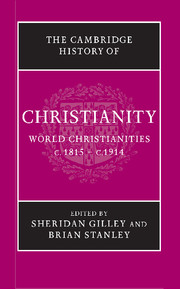Book contents
- Frontmatter
- 1 Introduction
- PART I CHRISTIANITY AND MODERNITY
- PART II THE CHURCHES AND NATIONAL IDENTITIES
- 14 Catholic Christianity in France from the Restoration to the separation of church and state, 1815–1905
- 15 Italy: the church and the Risorgimento
- 16 Catholicism, Ireland and the Irish diaspora
- 17 Catholic nationalism in Greater Hungary and Poland
- 18 Christianity and the creation of Germany
- 19 Anglicanism, Presbyterianism and the religious identities of the United Kingdom
- 20 Protestant dominance and confessional politics: Switzerland and the Netherlands
- 21 Scandinavia: Lutheranism and national identity
- 22 ‘Christian America’ and ‘Christian Canada’
- 23 Spain and Portugal: the challenge to the church
- 24 Latin America: the church and national independence
- 25 Between east and west: the Eastern Catholic (‘Uniate’) churches
- PART III THE EXPANSION OF CHRISTIANITY
- Select General Bibliography
- Chapter Bibliography
- Index
- References
16 - Catholicism, Ireland and the Irish diaspora
from PART II - THE CHURCHES AND NATIONAL IDENTITIES
Published online by Cambridge University Press: 28 March 2008
- Frontmatter
- 1 Introduction
- PART I CHRISTIANITY AND MODERNITY
- PART II THE CHURCHES AND NATIONAL IDENTITIES
- 14 Catholic Christianity in France from the Restoration to the separation of church and state, 1815–1905
- 15 Italy: the church and the Risorgimento
- 16 Catholicism, Ireland and the Irish diaspora
- 17 Catholic nationalism in Greater Hungary and Poland
- 18 Christianity and the creation of Germany
- 19 Anglicanism, Presbyterianism and the religious identities of the United Kingdom
- 20 Protestant dominance and confessional politics: Switzerland and the Netherlands
- 21 Scandinavia: Lutheranism and national identity
- 22 ‘Christian America’ and ‘Christian Canada’
- 23 Spain and Portugal: the challenge to the church
- 24 Latin America: the church and national independence
- 25 Between east and west: the Eastern Catholic (‘Uniate’) churches
- PART III THE EXPANSION OF CHRISTIANITY
- Select General Bibliography
- Chapter Bibliography
- Index
- References
Summary
Some seventy bishops of Irish birth and 150 of Irish descent are said to have attended the First Vatican Council in 1869–70. This reflected a great international phenomenon, the emigration of Irish Catholics to the United States and the four corners of the British empire in the century from 1815, in a river of people which became a flood during the Great Famine of 1846–9. The Irish ecclesiastical control of most of this emigration, outside Britain itself, was asserted by the Rome-trained and Rome-trusted Paul Cullen, archbishop of Armagh (1849–52) and then of Dublin (1852–78), apostolic delegate in Ireland with full authority from Rome, and from 1865 the first Irish cardinal. Cullen came to recommend the appointment of most of the bishops of the Irish diaspora, as it is now commonly known, and a stream of priests and religious also left Ireland to minister to their countrymen abroad, as the new territories slowly developed native Catholic institutions of their own.
This Irish empire of the spirit, compared by Catholics to the British Empire of the flesh, was rooted in the nineteenth-century Catholic Revival in Ireland itself, where despite the Penal Laws against the faith from the 1690s, four-fifths of the population had remained Catholic. The leading light of the revival was not a priest but the quintessential Irish Catholic layman, Daniel O’Connell (1775–1847), a utilitarian-minded lawyer, of Irish-speaking gentry stock, educated by English Catholics and at the English bar, and called the Liberator by his people. O’Connell reacted against the failure of the Irish rising of 1798 and against the union of the parliaments and established Protestant churches of England and Ireland to espouse the cause of a non-violent constitutional Catholic nationalism.
- Type
- Chapter
- Information
- The Cambridge History of Christianity , pp. 250 - 259Publisher: Cambridge University PressPrint publication year: 2005
References
- 1
- Cited by

